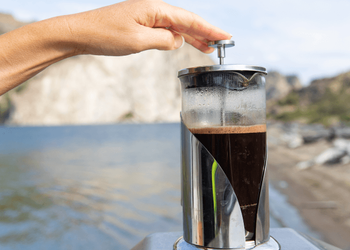
The Wonderful History (and Origins) of French Press

Welcome to the wonderful world of the French press, where coffee and history collide in the most delicious of ways!
The French press, also known as a cafetière or coffee plunger, may seem like a simple and unassuming device, but it packs a punch when it comes to brewing a rich and flavorful cup of joe.
This charming little gadget has been around for over a century and has quite the story to tell. From its humble beginnings in early 20th century France to its rise to coffee-making fame around the world, the French press has gained many fans.
So grab a cup of your favourite brew and let's dive into the fascinating history of the French press!
What is a French press?
The French Press is a simple and traditional way of brewing that gives you a rich and full-bodied cup of coffee. This coffee brewer basically is a cylindrical pot with a plunger and a metal or nylon mesh filter.
You add ground coffee and hot water to the pot, let it steep for a bit, and then press the plunger down to separate the grounds from the liquid. Voila! You've got yourself a delicious cup of coffee.
Compared to other methods of brewing, the French press extracts more oils and sediment from the ground coffee, which gives it a robust taste and creamy mouthfeel. Plus, it's super easy to use and clean.
Coffee grinds that are coarser, think cooking salt, work best in a French press. Finer coffee grounds require more force to lower the plunger because they have less permeability when immersed in water, so they are more likely to seep through the press filter and into the coffee beverage.
Moreover, finer grounds will tend to over-extract and cause the coffee to taste bitter.
History, origins, and Invention of a French press coffee maker
The exact date and inventor of the French press is not clear but it's believed (as per a legend) that the first version of the French press was patented by an Italian designer named Attilio Calimani in 1929.
However, there are also reports of a similar device being used in France as early as 1852. This was a rudimentary form of the press - a metal or cheesecloth screen fitted to a rod that users would press into a pot of hot water and coffee grounds.
The French press quickly gained popularity in France and soon spread to other European countries. A Danish company, Bodum, and a British company, Household Articles Ltd., helped popularise the device across Europe.
It wasn't until the 1950s that the French press began to gain popularity in the United States. Today, the French press is a popular choice for coffee enthusiasts around the world. Its simplicity, durability, and ability to produce a rich and full-bodied cup of coffee are some of the reasons why it has remained a popular choice for over a century.
Evolution of the French press
We recognize the design features of a French Press as a glass cylindrical vessel, a steel lid, and a round handle of the rod - a structure that actually gained popularity on the European market in 1958.
The brewer first was produced and distributed by a French company Martin S.A. under the name Chambord. Preserved through decades, Chambord is a classic. The company Martin S.A. produced it until 1991 when the company was bought by the Danish Bodum Holding.
Since 1991, Bodum has kept the Chambord design alive in its range of household products, making it one of the most well-known home-brewing devices.
The current state of the French press
Over the years, various technologies have been developed that have impacted the French press in different ways making coffee making the experience more convenient, efficient, and customizable. Here are a few examples of a modern French press.
- Electric French press: An electric French press is a variation of the traditional manual French press that is powered by electricity. These devices typically have a heating element that keeps the coffee warm, and some may also have a built-in grinder for added convenience.
- Insulated French press: Insulated French presses are designed to keep the coffee hot for a longer period. These presses often use double-walled construction with vacuum insulation, which helps to maintain the temperature of the coffee.
- Stainless steel French press: Stainless steel French presses are becoming more popular due to their durability, ease of cleaning, and rust resistance. They are also lightweight, easy to use, and can be used to make cold-brew coffee.
- Smart French press: Smart French press is a connected device that can be controlled via a smartphone app. These devices allow users to set the desired temperature and brewing time, and receive notifications when the coffee is ready.
Wrapping up
In conclusion, the French press has a rich and fascinating history dating back to the early 1900s. From its humble beginnings in Italy to its widespread popularity in Europe and eventually the world, the French press has become an integral part of coffee culture.
Today, millions of people enjoy the rich, bold flavor of French press coffee and the simple, elegant design of the press itself. We hope this brief history has sparked your interest in this classic brewing method and encourages you to try making your own French press coffee.
We would also love to hear about your own experiences with the French press, so please feel free to share them with us!
As he was boiling his water, this Frenchman realized he had forgotten to add coffee. As soon as he added the coffee grounds to the boiling pot, they stayed on the surface. To save his only portion of coffee, he bought a metal screen from an Italian merchant passing by. He fit the metal screen over the boiling pot, and he used a stick to press the screen down. Surprisingly the result turned out incredible, which resulted in the discovery of a new way of brewing coffee.

I am a barista by profession hailing from NC. My journey began in my late teens when I started working as a barista in a local coffee shop. My passion for coffee quickly became evident as I immersed myself in the art of espresso extraction, latte art ...



